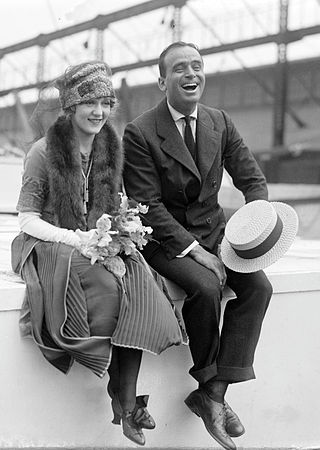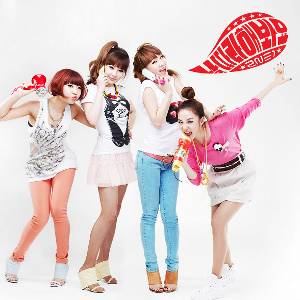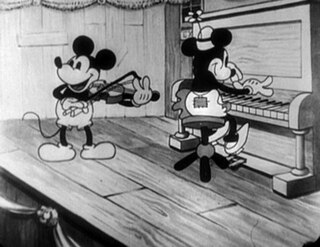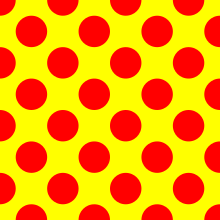
A kerchief, also known as a bandana or bandanna, is a triangular or square piece of cloth tied around the head, face, or neck for protective or decorative purposes. The popularity of head kerchiefs may vary by culture or religion, often being used as a Christian headcovering by men and women of the Anabaptist, Eastern Orthodox, and Plymouth Brethren denominations, as well as by some Orthodox Jewish and Muslim men and women and is also considered a hat.

Minerva "Minnie" Mouse is an American cartoon character created by the Walt Disney Company. As the longtime sweetheart of Mickey Mouse, she is an anthropomorphic mouse with white gloves, a red or pink bow, blue polka-dotted dress, white bloomers and low-heeled shoes occasionally with ribbons on them. The Mickey Mouse comic strip story "The Gleam" by Merrill De Maris and Floyd Gottfredson first gave her full name as Minerva Mouse, although this is seldom used.

A swimsuit is an item of clothing designed to be worn by people engaging in a water-based activity or water sports, such as swimming, diving and surfing, or sun-orientated activities, such as sun bathing. Different types may be worn by men, women, and children. A swimsuit can be described by various names, some of which are used only in particular locations or for particular types of suit, including swimwear, bathing suit, bathing attire, swimming costume, bathing costume, swimming suit, swimmers, swimming togs, bathers, cossie, or swimming trunks, besides others.

Yayoi Kusama is a Japanese contemporary artist who works primarily in sculpture and installation, and is also active in painting, performance, video art, fashion, poetry, fiction, and other arts. Her work is based in conceptual art and shows some attributes of feminism, minimalism, surrealism, Art Brut, pop art, and abstract expressionism, and is infused with autobiographical, psychological, and sexual content. She has been acknowledged as one of the most important living artists to come out of Japan, the world's top-selling female artist, and the world's most successful living artist. Her work influenced that of her contemporaries, including Andy Warhol and Claes Oldenburg.

Hip-hop fashion refers to the various styles of dress that originated from Urban Black America and inner city youth in cities like New York City, Atlanta, and Los Angeles. Being a major part of hip hop culture, it further developed in other cities across the United States, with each contributing different elements to the overall style that is now recognized worldwide.

In clothing for men, a dickey is a type of shirtfront that is worn with black tie (tuxedo) and with white tie evening clothes. The dickey is usually attached to the shirt collar and then tucked into the waistcoat or cummerbund. Some dickey designs have a trouser-button tab, meant to secure the dickey-bottom to the waistband of the trousers, and so prevent the dickey from becoming untucked.

Fashion in the 1990s was defined by a return to minimalist fashion, in contrast to the more elaborate and flashy trends of the 1980s. One notable shift was the mainstream adoption of tattoos, body piercings aside from ear piercing and, to a much lesser extent, other forms of body modification such as branding.

Fashion in the years following World War II is characterized by the resurgence of haute couture after the austerity of the war years. Square shoulders and short skirts were replaced by the soft femininity of Christian Dior's "New Look" silhouette, with its sweeping longer skirts, fitted waist, and rounded shoulders, which in turn gave way to an unfitted, structural look in the later 1950s.

The most characteristic North American fashion trend from the 1930s to 1945 was attention at the shoulder, with butterfly sleeves and banjo sleeves, and exaggerated shoulder pads for both men and women by the 1940s. The period also saw the first widespread use of man-made fibers, especially rayon for dresses and viscose for linings and lingerie, and synthetic nylon stockings. The zipper became widely used. These essentially U.S. developments were echoed, in varying degrees, in Britain and Europe. Suntans became fashionable in the early 1930s, along with travel to the resorts along the Mediterranean, in the Bahamas, and on the east coast of Florida where one can acquire a tan, leading to new categories of clothes: white dinner jackets for men and beach pajamas, halter tops, and bare midriffs for women.

Western fashion in the 1920s underwent a modernization. For women, fashion had continued to change away from the extravagant and restrictive styles of the Victorian and Edwardian periods, and towards looser clothing which revealed more of the arms and legs, that had begun at least a decade prior with the rising of hemlines to the ankle and the movement from the S-bend corset to the columnar silhouette of the 1910s. Men also began to wear less formal daily attire and athletic clothing or 'Sportswear' became a part of mainstream fashion for the first time.
"Polka Dots and Moonbeams" is a popular song with music by Jimmy Van Heusen and lyrics by Johnny Burke, published in 1940. It was Frank Sinatra's first hit recorded with the Tommy Dorsey Orchestra. The song is one of the top 100 most-frequently recorded jazz standards with arrangements by Gil Evans and others and notable recordings by Bill Evans, Chet Baker, Blue Mitchell, Wes Montgomery, Sarah Vaughan, Bud Powell, Lester Young, Gerry Mulligan, Lou Donaldson, Dexter Gordon and many others. American songwriter and guitarist John Denver also covered the song on his 1976 Spirit album. Bob Dylan covered this song in his 2016 album Fallen Angels.

A Dolly Varden, in this sense, is a woman's outfit fashionable from about 1869 to 1875 in Britain and the United States. It is named after a character in Charles Dickens, and the items of clothing referred to are usually a hat or dress.

The traje de flamenca or traje de gitana is the dress traditionally worn by women at Ferias (festivals) in Andalusia, Spain. There are two forms: one worn by dancers and the other worn as a day dress.

"Try to Follow Me" is a song by South Korean girl group 2NE1. It was originally released on February 9, 2010, to promote Samsung's "Corby CF" mobile phone. It later was released with the album "To Anyone" in September, 2010.

The 2010s were defined by hipster fashion, athleisure, a revival of austerity-era period pieces and alternative fashions, swag-inspired outfits, 1980s-style neon streetwear, and unisex 1990s-style elements influenced by grunge and skater fashions. The later years of the decade witnessed the growing importance in the western world of social media influencers paid to promote fast fashion brands on Pinterest and Instagram.

"The Creep" is a song by American comedy hip hop group the Lonely Island, released as the second single from their second studio album Turtleneck & Chain. It features rapper Nicki Minaj. Filmmaker John Waters also gives the introduction to the song as well as the last line of the song. He is credited as a featured artist on the album, but not the single. The song as well as its music video made its debut on Saturday Night Live on January 29, 2011.

The swan dress is a dress resembling a mute swan designed by Marjan Pejoski and worn by the Icelandic artist Björk at the 73rd Academy Awards on March 25, 2001, as well as on the cover of her album Vespertine. A Debenhams poll published in The Daily Telegraph in 2008 voted it the ninth-most iconic red carpet dress of all time. Björk's swan dress was reimagined by Valentino at its Spring 2014 Couture fashion show at Paris Fashion Week, which received praise from fashion blogs and social media. In 2019, the dress was featured in the Metropolitan Museum of Art for the exhibition Camp: Notes on Fashion.

A stripe is a line or band that differs in color or tone from an adjacent area. Stripes are a group of such lines in a repeating pattern of similar regions.

The Shindig is a Mickey Mouse short animated film first released on July 11, 1930, as part of the Mickey Mouse film series. It was the twentieth Mickey Mouse short to be produced, the fifth of that year.

The fashions of the 2020s represent a departure from 2010s fashion and feature a nostalgia for older aesthetics. They have been largely inspired by styles of the late 1990s to mid-2000s, 1980s, and late 1960s to early 1970s Early in the decade, several publications noted the shortened trend and nostalgia cycle in 2020s fashion. Fashion was also shaped by the COVID-19 pandemic, which had a major impact on the fashion industry, and led to shifting retail and consumer trends.





























